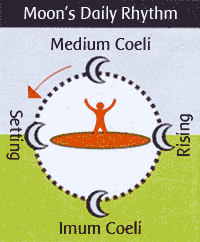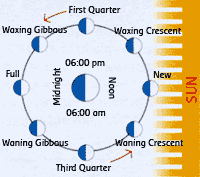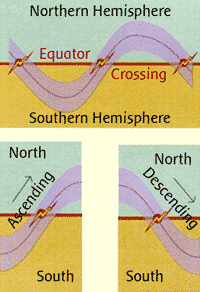About The Northern Hemisphere Astro Calendar – Working and Living with the Cosmic Rhythms
Context to Working with Rhythms
There is no set formula for planting to cosmic rhythms. Five of the lunar cycles are approximately a month long; however none of them are exactly the same length or synchronous, which allows for ever-changing relationships. One has to read into the various influences shown on the calendar, look at the prevailing weather conditions, judge soil moisture and available time, etc. Common sense is a primary ingredient and although lunar rhythms are covered extensively in the calendar, there are planets, stars and the Sun to consider too. They all act in concert. In the midst of this music, we may question: "As human beings, who are we, and what is our role?"
Understanding the Daily Lunar Rising and Setting Rhythms

At a different time each day the Moon rises; climbs to its greatest height above the horizon (Medium Coeli, MC); loses altitude until it meets the horizon again (moonset); then goes to its greatest depth below the horizon (Imum Coeli, IQ); before heading up for moonrise again. This Moon day lasts some twenty-four hours and fifty minutes and has four distinct beats to it which are reflected in the weather. When the Moon is well below the horizon you can notice a tendency toward cloud formation as the heavens lower and water vapors condense. When the Moon is high above the horizon at its culmination you can notice a general clearing of the skies as they lift, breathing upwards and outwards with the atmospheric high tide. When the skies lower, a greater contraction is taking place, which can lead to the water vapor condensing to clouds. If the clouds lose the battle with gravity we have nimbus formations and the associated rain. To find out when the Moon is above or below the horizon (apart from observation) look at the rising and setting times given in the calendar. The MC and IC will be midway between the two times. Note also how often rain or a changing skyscape begins with the Moon on the horizon. Even some animal behaviors change. The phenomena of events on our horizon, like sunset or moonrise, are quite extraordinary. Who has not experienced the effect on one's soul life when participating in a sunset or full Moon rising? Presumably this will also be the case for planets rising too, but perhaps on a more subtle level.
Daily Earth Rhythm
From 3:00 am to around 3:00 pm it is as if the Earth is exhaling (e.g. mists and scents rising). From 3:00 pm to around 3:00 am there is a contraction and inhalation (dew fall). Working in harmony with this rhythm one could, for example, harvest herbs early in the morning, when the plant's vitality is still contained within itself, and transplant in the evening when the plant has regathered all of itself.
Long Term Rhythm – 18.6 Year Cycle
Over a period of 18.6 years the Moon moves from an expanded range of 5 degrees beyond the two Tropics (where the Sun ranges 23°26' North and South) and then retreats to confine herself within 5 degrees of the Tropics; and then expands back again. When the lunar declinations (movements North and South of the equator) are concentrated, it is as if the lunar water membrane is more concentrated and the weather more dynamic. One can swing from floods to droughts in very short time periods. Drought cycles are more associated with declination maximums. Note from the calendar at Peak South and North times how much the lunar declinations vary from 23°26' to obtain a sense of whether this long term rhythm is in on expanding or contracting phase. It is a major factor in weather phenomena!
Monthly Rhythms: Phase Cycle Synodic Rhythm with the Sun (29.5 Days)

This rhythm we are all familiar with but it is only one of five monthly lunar rhythms. 'Syn' means together and it is the rhythm of the Moon together with the Sun. Sunlight reflected by the Moon increases over a fortnight to full Moon and then the polar darkness starts to win over as we move towards new Moon. There is a continual tussle between light and levity against darkness and gravity. Plants hove been shown to have a greater metabolic activity and absorption rate towards full Moon and seeds germinate faster. However do not plant exactly at the full Moon as a rhythm impulse is in the midst of change and results ore unpredictable.
Rudolf Steiner's View
Rudolf Steiner suggests that a flush of fertility/ growth forces comes to the Earth with every full Moon. To understand this statement, it can be helpful to compare one organism to another – the Earth with the human being. Every month bodily fluids like vaginal mucous, saliva and blood undergo concurrent rhythmic changes in the female organism. For a few days in every menstrual cycle the mucous has a subtle change in consistency which is conducive for insemination. I see this as the some rhythm expressed in Nature at the time of the full Moon. At this time only, and not all month, the Earth is open to being fertilized through her water organization with life forces of light from the paternal Sun. The new Moon is the dark, inward, gravity bound period of the month and could be compared to menstruation when the uterus lining, succumbing to gravity, falls out of the life sphere if the egg matrix (mater – mother) is not patterned (pater – father) by semen. In 1939, ionosphere researchers Appleby and Weekes, found that shortwave radio signals traverse the world more clearly at new and full Moon phases. The atmospheric menstruum, although invisible, nonetheless has some kind of structure. I would not be surprised if the shortwave signals are qualitatively different to each other at these syzygies (planetary bodies in a straight line as at new and full Moons). I have mentioned one daily and one monthly rhythm of the Moon with which it is easy to become familiar. There are four more major circa-monthly rhythms of the Moon to consider.
Monthly Rhythms: Ascension/Descension Cycle – Tropical Rhythm Between the Hemispheres (27.2 Days)

It is often confused with the waxing/waning cycle (Moon phases). Essentially this is a mini¬cycle of the Sun's varying heights from summer to winter when it swings between the tropics of Cancer and Capricorn. In the Northern Hemisphere the summer solstice in June finds the Gemini Sun at its highest path in the northern sky (Peak North). Peak South will be on the December solstice with the Sun having a low path across the sky in Sagittarius. When the Sun ascends (goes north in the monthly charts) into spring and summer, the Earth breathes out and nature surges upward. The Moon does a similar movement but twelve times faster than the Sun. She moves from the tropic of Cancer to Capricorn in two weeks, rather than six months. When the Moon ascends, (sine wave curving northwards) the plant vitality moves into its upper reaches, like a mini spring and summer. This is reinforced if the Sun and Moon or planets ascensions are synchronous, and tempered if they are not. With a descending Sun the Earth breathes in, and the plant's main activity withdraws into the root zones. So too with the Moon's descension, but to a lesser degree – a mini autumn and winter. The Moon climbs (culminates higher) for a fortnight and with this pulse can come warmer weather from the tropical south especially if the Sun is also ascending. Then the weather becomes relatively cooler as the Moon goes bock down and northern weather systems move southwards. N.B. Frontal activity modifies these overall wormer/cooler trends. When the Moon turns at peak ascension and descension, there will be a change from expansion to contraction or vice versa and we can expect to have some turbulence bringing with it wind and sometimes rain. Expect turbulence at equatorial crossings too. The ascending periods are considered favorable for grafting and the application of preparation 501 (biodynamic spray), but not for pruning when open wounds could bleed too much. In the descending period, which lasts a fortnight, the increased vitality within the soil makes it appropriate for activities like the spraying of preparation 500 (biodynamic spray), compost making, and transplanting. It is remarkable how well plants do transplant at these times, especially when carried out in the evenings as well. Root growth is immediate, enabling rapid reestablishment. Maria Thun advocates the planting of all seeds during lunar descension, whereas other folk only sow root crops at this time. Higher tides occur around Peak Ascension, as does bulkier, more rapid plant growth.
Monthly Rhythms: Sidereal Cycle – Zodiac Rhythm Amongst the Stars (27.3 Days)
This is the length of time for the Moon to journey through the whole zodiac ("sider"=star). The zodiac, technically, is the star background band against which the Sun, Moon and planets travel. The constellations of the sidereal zodiac are divided into 12 equal or unequal divisions encompassing 360°. In this calendar the constellations are equally sized at 30° each.
Monthly Rhythms: Apsidal Cycle – Lunar Expansion and Contraction Rhythm (27.55 Days)

The Moon has an elliptical orbit varying quite markedly in its distance from the Earth. When the Moon is close to the Earth (perigee) the water pulsations are stronger. If they are complemented by a Full Moon or Peak South, they are stronger still. A situation con be too strong however, and if two or more of these rhythms come into phase, when conditions are already wet, one could expect a high incidence of rotting and fungal attacks. Naturally these would be times of big swells and very high tides in the molten lavas, seas, atmosphere and plant saps. Towards lunar perigee there is a higher chance of rain and consequently better chance of bulkier plant growth. Plants such as beans, potatoes, carrots, radish and rye planted at the time of perigee have been shown (by Spiess) to give higher yields. At apogee, with the Moon at its farthest distance from Earth, levitational forces would be at their weakest, and gravity forces strongest. Look adjacent to the Pg and Ag letters on the monthly charts to get the actual Earth–Moon distances. This cycle could be seen as a rhythm of balance between Earth and Moon and is part of the greater annual pulse between the Earth and Sun. Around January 4 each year, the Earth is at its closest to the Sun (perihelion) and near July 4, she is farthest away, at aphelion.
Monthly Rhythms: Nodal Cycle – Rhythm of the Eclipses (27.6 Days)

The Moon and planetary orbits ore inclined to the ecliptic (Sun's annual path across the sky). The points where they cross the ecliptic are called nodes and there are two nodes per each planetary revolution around the Sun. It is only at nodal points that eclipses can occur. Agnes Fyfe deduced from her research work that even if an eclipse is not visible from a certain location, it still has an effect on plants in that location. Occultations, similar to eclipses, occur when a planet is blocked from view by the Moon or a planet (similar to an eclipse but the Sun is not involved). This fifth period is from the ascending Moon node to the next ascending node. When there is a lunar node, the Moon, Sun and Earth (geocentric perspective) are on the same plane. Perhaps this is akin to a meeting between three individuals in a three-story building; you have to be on the same floor (the same plane) to meet fully. You meet because your working plan together needs renewing. During the meeting there is no clear direction and there can be a state of angst. After the meeting a plan is set in place for a definite period. One might wonder if the Beings behind the planetary bodies meet to put plans in place for the solar system. The question facing us is: "Do plants have a clear direction at the time of a node?" If you wish to play safe you could avoid planting two hours either side of the lunar node. For planetary nodes, the slower the planet, the more time you would allow for this crossing of the ecliptic.